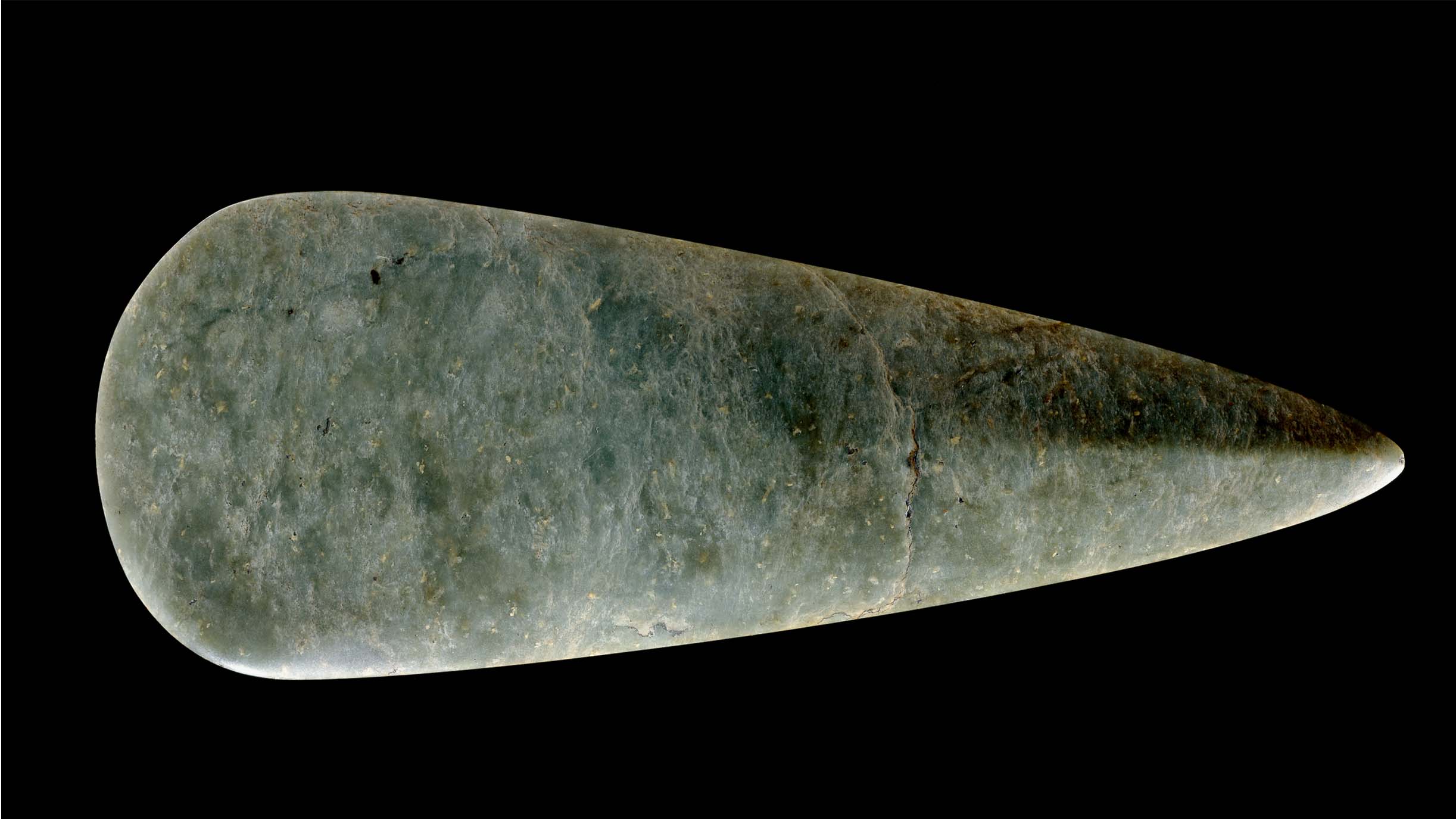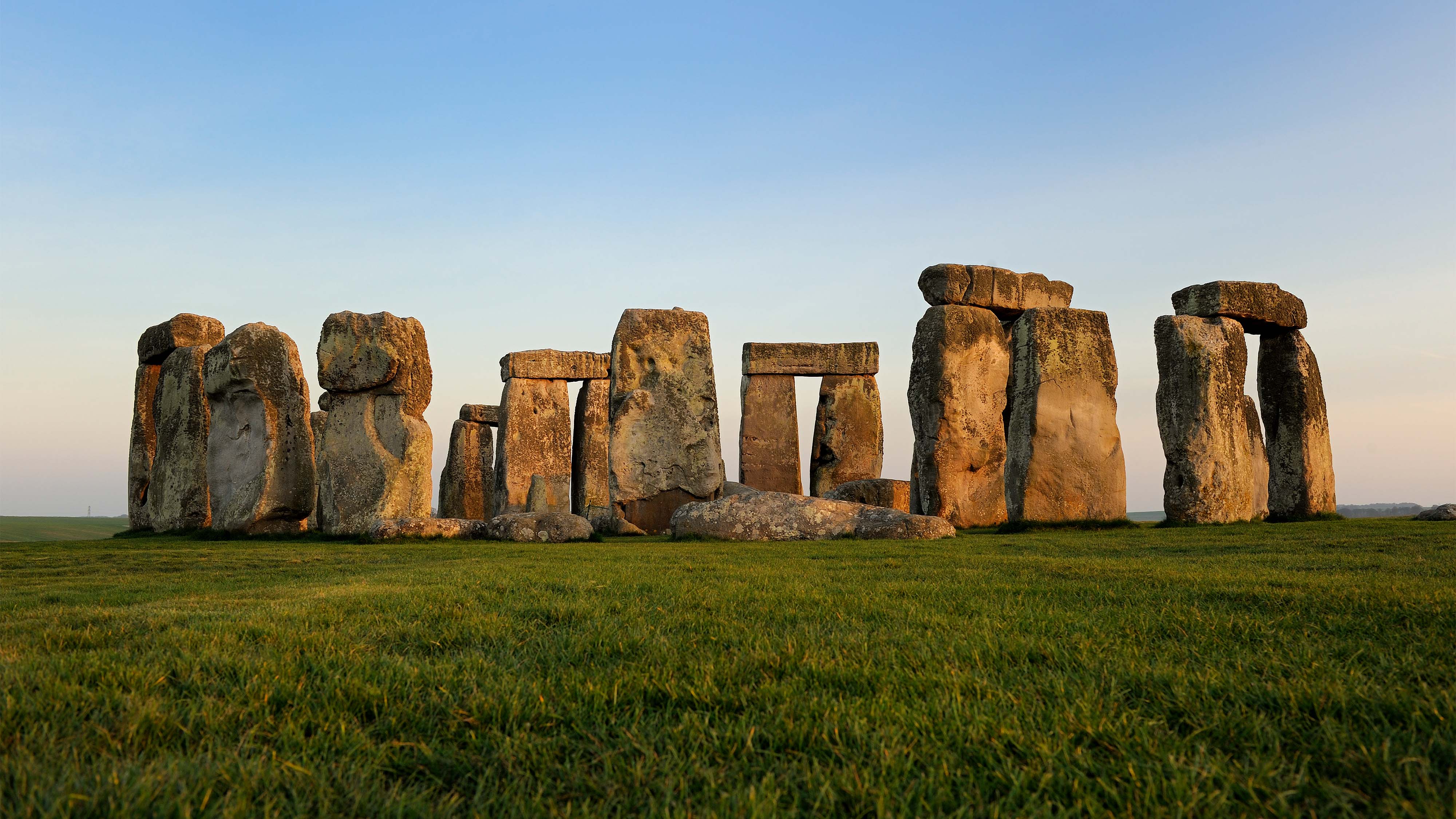Reading the rocks: Stonehenge, tools, time & memory
While visiting the British Museum exhibition The World of Stonehenge, Jeremy Rye wonders about crafted stone and uses it to consider time, shared memory, and our relationship to matter. Looking at the marks on an axe head and landscape stone can help us think about how our ancestors considered their place.

fig.i
I am left with a disturbing feeling that we have lost more than we claim to now know about what our ancestors, the people from our deep history, created in the tools they made, from the axe and mace head, to the largest henge. I had this feeling while standing in front of a display of axes at The World of Stonehenge, a British Museum exhibition exploring the 4,500-year-old monument, its myths and histories. Each axe is made of stone, beautiful in their given form, shaped for the utilitarian function they were designed to perform.
The word “perform” stays in my brain. There is a danger in seeing artefacts purely as historic museum objects rather than items which once had lives, that they are overlayed with a sense of performance that obscures the reality for which they were formed. An obsession with understanding the how and why has me creating imagined stories and narratives in which I can place the object as protagonist, supporting my need to rationalise their context and imagine their life lived. I feel it’s my need to find that connection, to align these objects to an imagined individual I can identify with – shaping my response to these exhibits, how I choose to understand them, and the way I compartmentalise them safely in a way that fits my “superior” modern understanding of the world.

fig.ii
While looking at these axes, I weave a scenario in my head, peopling and texturing it with trees, animals, furs, and skins. I can feel myself hunting for connections that make this object real to me as a creation by an unmet ancestor. All I feel, though, is a sense I am profoundly missing the point – I am considering the item not for its own being but through its creator, when what perhaps I need to do is consider the formed object as the life itself.
The axes are from all over the country, refashioned of local stone into new form and beauty. I see in them not only form, but how material has been understood and celebrated – the creators revealing texture and colour, striations and layers. I feel that it was in the process of making that my ancestors found its meaning within. I think of how it’s said of Michaelangelo that he felt the sculpture was always deep within the marble block, and all he was doing was releasing its true form, and I see how the artist’s presence remains with us eternally through the form of that creation.
In my struggle to feel a connection with these ancestors, initially I wasn’t considering their own connection to material. Slowly, I think perhaps what I should be doing is searching to feel the same connection with the axe head in front of me, considering them not as museum object but as source material. I start with one of the axes, trying to see it not as a tool, but as crafted stone.
I begin to see that celebrated material, and through it a sense how my ancestors might have felt themselves at one with earth’s matter, in a way we don’t – or can’t – now. A oneness with stone. I try to hold a feeling of myself as if the original craftsman – how I would have had respect for the stone, and in transforming it into a tool would endow it with respect, and through it’s eventual utilisation treat its future prey – whether flora or fauna – with an equal respect.
Whether adherent to Gaia theory or not, many of us have come round to a sense that all in this world is interlinked. But perhaps this is less a new invention and more a reclamation of a concept lost, or wilfully ignored. Something our ancestors intrinsically understood.
I see it in these axes and mace heads. For each I see that as tools they would still function perfectly, if only their aesthetic value didn’t supersede their utility value. I feel that they were made for an eternal use, or at least with a knowing that the object’s purpose would outlive the life of the maker, and that it is made knowing that this carefully carved axe will have future users who will never be met, though the maker’s presence will indelibly be continued through the object, its marks and being.
In the way my ancestor handled and formed the object, how within a lump of stone they saw an axe head, and how they respected and learnt the material. I sense there was a conversation between man and matter. Together, they decided to reveal the axe form, and through that process of becoming the life of the maker becomes intwined with the material, the eternal absorbing finite.
Now I, a later relative the maker will never meet, stand in front of this axe, and by looking I get to see not only the tool but the person. Not by imagining them working the stone as I had tried to earlier in mental performance, but now seeing them within the stone itself.
Having developed my looking to see the maker within the object, I can also transfer my thoughts to marks left on landscape stones. Contrasting with an object made from a single stone, then removed from its location as tool, these were worked in situ, then left in the land for others to discover, seemingly without immediate reward or benefit.
![]()
fig.iii
This landscape stone is thought to have been started by one person, then added to by others – like progressive graffiti. A cup mark repeatedly impressed into the rock by several people is not a making in the traditional mode, but an accumulation of symbols. In the mark-making each compresses a piece of themselves into a slow removal of matter. Just as with the axe or mace, this action celebrates material, transcribing a message of identity within it for an unknown future, including me in this exhibition.
Could my ancestors sense more than we can today in these recessed marks? We may read it as design, aesthetic or sculpture, but it feels like it contains more than form. Would we, without any knowledge of who Michelangelo was, still know him through his sculpture, through only the marks he left?
These stone objects remain in the landscape exactly where they were made, and today we walk past as our ancestors did before. We don’t need to know why they made them or what their landscape meant, it is enough for me that there is a place where little has physically changed, where my footsteps coincide with theirs. If in their making they had an intent of eternity, then I don’t need to make a new physical mark on the rock, just noticing its genesis continues its intended story. Even if our species disappears, the marks remain.
Is it possible for me to create with an idea of eternity? Would my attitude to art or architecture alter if my project remained for eternity, and if only through it – not my face, name, or reputation – would a memory of me remain?
As I step away from the rocks and stone arrow heads in front of me, I wonder if culturally and socially we don’t forget concepts but they are momentarily misplaced, to be rediscovered by those that follow, and through artefacts like these an embedded message can be recalled. A message of interconnectedness and memory.
![]()
fig.iv
Jeremy Rye is a multidisciplinary designer with a particular focus on historic, sustainable and wilding landscapes.
He is an accomplished designer, landscape architect and teacher with 16 years of professional experience working with a variety of private and commercial clients in UK and Europe. His schemes have won awards, the most notable being the London Planning Award 2016, Best New Public Space. A current project has been shortlisted for the World Architecture Festival 2021 award.
www.jeremyrye.com
The World of Stonehenge is the UK’s first ever major exhibition on the story of Stonehenge. Key loans include the Nebra Sky Disc, the world’s oldest map of the stars which is on loan to the UK for the very first time, and the astonishing wooden monument – dubbed Seahenge – that recently emerged after millennia from the sands of a Norfolk beach.
17 February – 17 July 2022
www.britishmuseum.org
images
fig.i Stonehenge,
© English Heritage
fig.ii Fine jadeitite axe-head made from material quarried in the high Italian Alps, c. 4500–3500 BC, © The Trustees of the British Museum
fig.iii Stone with cupmarks, exhibited at The World of Stonehenge, © Jeremy Rye
fig.iv
Stonehenge, © English Heritage
publication date
24 February 2022
tags
British Museum, Craft, Looking, Material, Memory, Jeremy Rye, Stone, Stonehenge, Tools
fig.ii Fine jadeitite axe-head made from material quarried in the high Italian Alps, c. 4500–3500 BC, © The Trustees of the British Museum
fig.iii Stone with cupmarks, exhibited at The World of Stonehenge, © Jeremy Rye
fig.iv Stonehenge, © English Heritage
publication date
24 February 2022
tags
British Museum, Craft, Looking, Material, Memory, Jeremy Rye, Stone, Stonehenge, Tools




